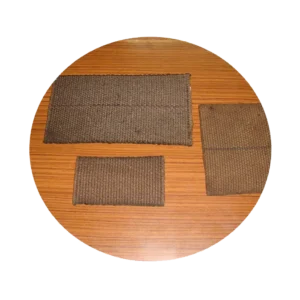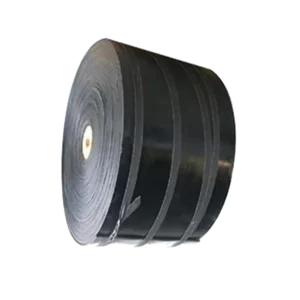| Product Name | Cotton Conveyor Belt |
|---|---|
| Material | Cotton |
| Processing Service | Cutting |
| MOQ | 5000 Pieces |
| Supply Ability | 50000 Pieces |
| Brand Name | Balaji International |
Appendix A
Methods of Conducting Tensile and Elongation Tests
A-0. Conditioning of Sample
A-0.1 Before testing, condition the test piece to moisture equilibrium in a standard atmosphere of 65 ± 2 percent relative humidity and 27° ± 2°C temperature (see also IS:196-1950) for at least 24 hours, and immediately.
A-1. Tensile Test
A-1.1 From the selected sample, cut a piece of about one metre in length and condition it as given in A-0.1. Fix the wedge grips squarely at both ends, leaving about 20 mm length free at each extreme end. Push into free ends steel pins, about 400 mm long, 25 to 40 mm distance between centres, along the width adjacent to the back of the wedge grips to prevent slipping of these grips. Slide the belting with the grips fitted as mentioned above into the grip holders (in the form of tapered fork pieces) in such a way that the wedge grips at each end of the belting are held firmly and squarely between the jaws of the grip holders
A-1.2 Apply the load gradually between the grip holders, the rate of traverse of moving end being not less than 300 mm per minute, until rupture.
A-2. Elongation Test
A-2.1 Prepare and mount a sample strip of about 3.4 metres as in A-1.1. Mark a gauge length of 3 metres and apply a load of 1.12 kg/mm² of nominal cross-section for 15 minutes. Calculate the elongation as percentage of the initial guage length of the test strip.
A-3. Permanent Set
After temoving the load from the test piece mentioned in A-2.1, allow the belting to rest freely for 24 hours and calculate the permanent set as a percentge of the original length.
Appendix B
Information to be given with enquiry or when placing an order
B-1. The following information should br supplied by the purchaser when making an enquiry or placing an order for a belt:
a) Maximum power to be transmitted.
b) Belt speed (or diameter and rpm of driving pulley);
c) Width of pulleys;
d) Diameters of pulleys;
e) Positions and diameters of snub and idler pulleys;
f) Centre to centre distance of pulleys;
g) Type of drive, that is, open or crossed; horizontal of inclined; particulars of machinery; tightside – upper or lower; type of fork used, if any;
h) Conditions under which belt is to br used, particularly whether corrosive liquids or vapours are present and
j) Other relevant details of operating conditions.





